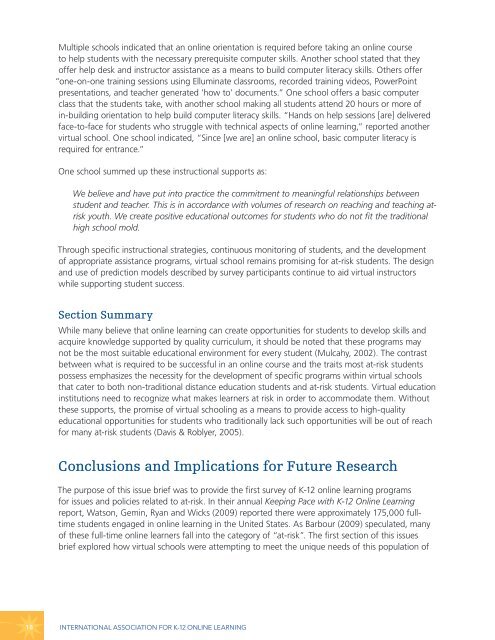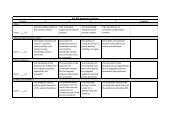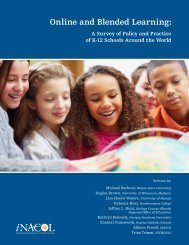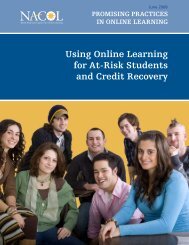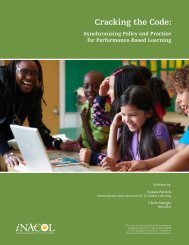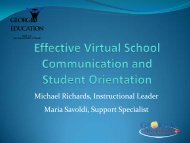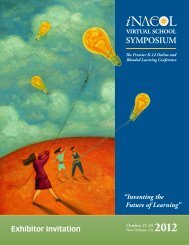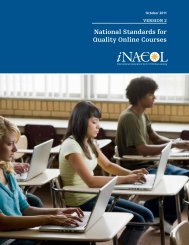An Exploration of At-Risk Learners and Online Education - iNACOL
An Exploration of At-Risk Learners and Online Education - iNACOL
An Exploration of At-Risk Learners and Online Education - iNACOL
You also want an ePaper? Increase the reach of your titles
YUMPU automatically turns print PDFs into web optimized ePapers that Google loves.
Multiple schools indicated that an online orientation is required before taking an online course<br />
to help students with the necessary prerequisite computer skills. <strong>An</strong>other school stated that they<br />
<strong>of</strong>fer help desk <strong>and</strong> instructor assistance as a means to build computer literacy skills. Others <strong>of</strong>fer<br />
“one-on-one training sessions using Elluminate classrooms, recorded training videos, PowerPoint<br />
presentations, <strong>and</strong> teacher generated ‘how to’ documents.” One school <strong>of</strong>fers a basic computer<br />
class that the students take, with another school making all students attend 20 hours or more <strong>of</strong><br />
in-building orientation to help build computer literacy skills. “H<strong>and</strong>s on help sessions [are] delivered<br />
face-to-face for students who struggle with technical aspects <strong>of</strong> online learning,” reported another<br />
virtual school. One school indicated, “Since [we are] an online school, basic computer literacy is<br />
required for entrance.”<br />
One school summed up these instructional supports as:<br />
We believe <strong>and</strong> have put into practice the commitment to meaningful relationships between<br />
student <strong>and</strong> teacher. This is in accordance with volumes <strong>of</strong> research on reaching <strong>and</strong> teaching atrisk<br />
youth. We create positive educational outcomes for students who do not fit the traditional<br />
high school mold.<br />
Through specific instructional strategies, continuous monitoring <strong>of</strong> students, <strong>and</strong> the development<br />
<strong>of</strong> appropriate assistance programs, virtual school remains promising for at-risk students. The design<br />
<strong>and</strong> use <strong>of</strong> prediction models described by survey participants continue to aid virtual instructors<br />
while supporting student success.<br />
Section Summary<br />
While many believe that online learning can create opportunities for students to develop skills <strong>and</strong><br />
acquire knowledge supported by quality curriculum, it should be noted that these programs may<br />
not be the most suitable educational environment for every student (Mulcahy, 2002). The contrast<br />
between what is required to be successful in an online course <strong>and</strong> the traits most at-risk students<br />
possess emphasizes the necessity for the development <strong>of</strong> specific programs within virtual schools<br />
that cater to both non-traditional distance education students <strong>and</strong> at-risk students. Virtual education<br />
institutions need to recognize what makes learners at risk in order to accommodate them. Without<br />
these supports, the promise <strong>of</strong> virtual schooling as a means to provide access to high-quality<br />
educational opportunities for students who traditionally lack such opportunities will be out <strong>of</strong> reach<br />
for many at-risk students (Davis & Roblyer, 2005).<br />
Conclusions <strong>and</strong> Implications for Future Research<br />
The purpose <strong>of</strong> this issue brief was to provide the first survey <strong>of</strong> K-12 online learning programs<br />
for issues <strong>and</strong> policies related to at-risk. In their annual Keeping Pace with K-12 <strong>Online</strong> Learning<br />
report, Watson, Gemin, Ryan <strong>and</strong> Wicks (2009) reported there were approximately 175,000 fulltime<br />
students engaged in online learning in the United States. As Barbour (2009) speculated, many<br />
<strong>of</strong> these full-time online learners fall into the category <strong>of</strong> “at-risk”. The first section <strong>of</strong> this issues<br />
brief explored how virtual schools were attempting to meet the unique needs <strong>of</strong> this population <strong>of</strong><br />
18<br />
International Association for K-12 <strong>Online</strong> Learning


